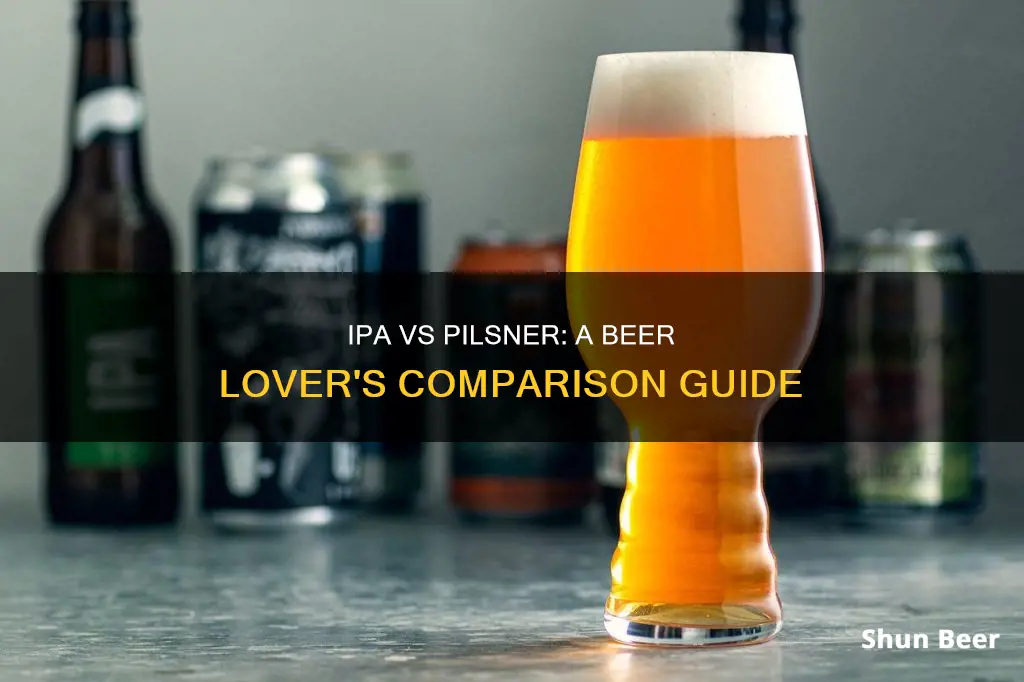
India Pale Ale, or IPA, is a style of ale, while Pilsner is a style of lager. The two top-level types of beer are differentiated by how they are made, primarily the temperature conditions of fermentation. Ales are created through top fermentation, where yeast ferments at warmer temperatures and settles at the top of the beer. Lagers, on the other hand, are fermented at cooler temperatures, and the yeast settles at the bottom of the beer.
IPAs are known for their strong hoppy flavour, with a slightly or extremely bitter taste. They usually have an amber and cloudy colour, but they now come in a range of darker and lighter colours. Pilsners, on the other hand, are hoppy rather than malty, with a crisp bitterness and some floral notes. They are golden in colour, with a soft white head and the spicy flavour and aroma of noble hop varieties.
What You'll Learn

IPA is a style of ale, Pilsner is a style of lager
India Pale Ale, or IPA, is a style of ale. Pilsner, on the other hand, is a style of lager.
The two top-level types of beer are ale and lager, differentiated by how they are made, specifically the temperature conditions of the fermentation. Ales are created through top fermentation, a process in which yeast ferments at warmer temperatures and settles at the top of the beer. Lagers are made with bottom-fermenting yeast, which ferments at cooler temperatures and settles at the bottom of the beer.
IPAs tend to be citrusy and piney in flavour and can lean towards bitterness. They also tend to have a higher alcohol content. Pilsners, on the other hand, are hoppy rather than malty, resulting in a crisp bitterness with some floral notes. The taste can vary, however, as there are many types of pilsners.
In terms of colour, IPAs are usually amber and cloudy, but they can also come in a range of darker and lighter colours. Pilsners, originating from the Czech Republic, are typically light golden and notable for their clarity, although Czech pilsners tend to be a little darker.
In terms of strength, IPAs usually have an ABV of 4.5-6%, but some brewers have recreated original IPAs with an ABV closer to 8 or 9%. Pilsners usually have an ABV of around 5%.
IPA Beer: Does It Expire and When?
You may want to see also

IPAs tend to be citrusy and bitter
IPAs, or India Pale Ales, tend to be citrusy and bitter. This is largely due to the use of hops in the brewing process, which can also result in herbal or fruity flavours. The hops in IPAs give the beer a strong, hoppy flavour that can range from slightly to extremely bitter.
The bitterness of an IPA is influenced by the variety of hops used, with some IPAs tasting purely of citrus, while others are strong and bitter. For example, New England IPAs are known for their fruity flavour and low bitterness, whereas British IPAs tend to be maltier and more bitter. West Coast IPAs strike a balance between fruitiness and bitterness.
The bitterness of an IPA can also be attributed to its high alcohol content. Traditionally, IPAs were brewed with a higher alcohol content to prolong their shelf life during transport. The extra alcohol, along with the addition of hops, acted as a natural preservative, preventing the beer from spoiling.
The citrusy and bitter flavours of IPAs can be quite intense, and these beers are often described as "hoppy". The strong flavour of IPAs is a result of the brewing process, which involves adding more hops and malt to the beer. The balance of these ingredients gives IPAs their distinctive character.
Overall, IPAs are known for their citrusy and bitter flavours, which can vary in intensity depending on the specific style and ingredients used. The bitterness of an IPA is a defining characteristic that sets it apart from other types of beer, such as pilsners.
Prepare Delicious Corned Beef with Guinness Beer at Home
You may want to see also

Pilsners tend to be hoppy and crisp
Pilsners tend to be hoppy rather than malty, so they have a crisp bitterness with some floral notes. German pilsners give off a pale gold colour and a crisp flavour, while Czech pilsners are a little darker with higher bitterness. Pilsners are usually light and refreshing, with a notable clarity. They have strong hops (but not as strong as IPAs), softer malt, fragrant, and pleasurably bitter flavours. They are typically 5% ABV.
Pilsners are made with bottom-fermenting yeast that has a lower tolerance for alcohol. They can taste light and a little malty. Pilsners are a typical entry point for new drinkers. They are clean, consistent, and well-made, and not particularly challenging in terms of flavour.
The Bitterness of IPAs: Fact or Fiction?
You may want to see also

IPAs are usually stronger than Pilsners
IPAs, or India Pale Ales, are usually stronger than Pilsners. This is because IPAs tend to have a higher alcohol content, which is a result of the traditional method of production. Pilsners, on the other hand, are a type of lager, which typically have a lower alcohol content.
IPAs were originally created to survive the long journey from England to India during the 1700s. Brewers added more hops, a natural preservative, to prolong the beer's shelf life. However, this also increased the alcohol content. While modern IPAs may have a more moderate alcohol content, they still tend to be stronger than Pilsners.
The specific type of hops used in IPAs also contributes to their strength. American hops, for example, can make IPAs extremely aromatic and flavourful. West Coast IPAs tend to be particularly strong, with a prominent hoppy flavour.
Pilsners, on the other hand, are known for their crisp, refreshing taste. They are usually lighter in colour and have a notable clarity. While they may have a slightly higher alcohol content than some other lagers, they are still typically lower in alcohol than IPAs.
In terms of flavour, IPAs tend to be very hoppy, with a bitter taste. Pilsners, on the other hand, are more balanced, with a mix of hoppy and malty flavours. This gives them a crisp bitterness with some floral notes.
Overall, while there may be some variation depending on the specific style and ingredients used, IPAs are generally stronger than Pilsners in terms of both alcohol content and flavour.
Guinness Beer's Thick Con: Why the Creamy, Dark Con?
You may want to see also

Pilsners are the most popular style of beer in the world
Pilsners are characterised by their light golden colour, and crisp, hoppy taste. They are typically between 4% and 6% alcohol and are known for being delicate, complex, refreshing, and easy to drink. The soft water used in the brewing process, along with the use of local Saaz hops, gives Czech pilsners a soft texture and balanced flavour profile.
The style is considered one of the most difficult to brew, due to the complex brewing and fermentation processes involved, and the need for intense attention to detail. However, this challenge is part of the appeal for many brewers, who see Pilsners as a way to showcase their skills.
The popularity of Pilsners has endured, with the style embraced by craft brewers in recent years. The simple, classic nature of the beer, along with its refreshing taste, makes it a favourite among beer drinkers around the world.
Understanding IPA Beer Allergies and Their Causes
You may want to see also
Frequently asked questions
IPAs are a style of ale, while Pilsners are a style of lager. IPAs tend to be hoppy, bitter, and citrusy, while Pilsners are crisp, clean, and refreshing.
IPAs typically have an ABV of 4.5-6%, but some brewers have created IPAs with an ABV closer to 8 or 9%. Pilsners usually have an ABV of around 5%.
IPAs usually have an amber colour, but can also come in darker and lighter shades. Pilsners are typically a light golden colour, but German and Czech Pilsners can be slightly darker.
IPA stands for India Pale Ale, which was originally created for English troops in India. Pilsner gets its name from the Czech city of Plzn (Pilsen), where it was first brewed.







